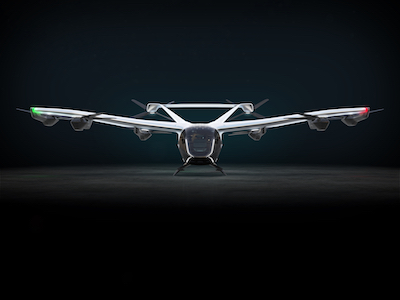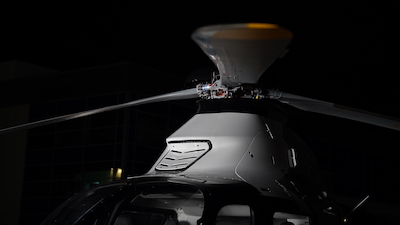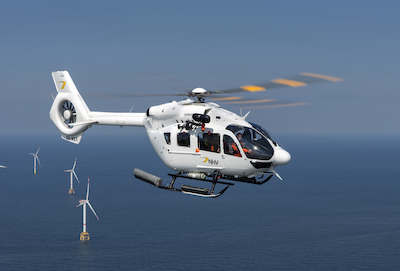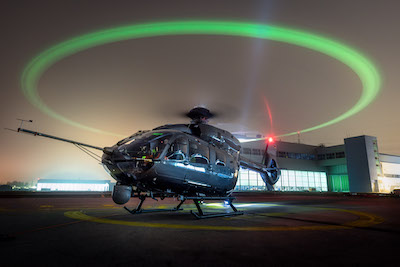|
Jun
13
2023
|
|
Posted 2 years 216 days ago ago by Admin
|
|

Photo by Airbus Helicopters
Airbus Helicopters offers vertical lift platforms with an eye on the future of technology, efficiencies, and the worldwide helicopter market. They understand their business and stakeholders’ goals. Recently, in France and at Heli-Expo 2023 in Atlanta, they held press briefings for each of their key lines to provide updates on new technologies and features that will engage the industry and buyers. Here are the updates, starting with the most emerging and engaging topics…
Urban Air Mobility Program
Airbus is one of many companies that entered the urban air mobility (UAM) space in recent years. CEO of Airbus UAM Balkiz Sarihan provided a pre-Heli-Expo briefing called “CityAirbus NextGen: Building Advanced Air Mobility Services One Step at a Time.” She offered a holistic perspective to how Airbus is going to make UAM a reality. Sarihan, a leader from Turkey and Canada, brought a calm and professional bright edge to presenting program facts. Listening to her proposition about UAM is like spreading butter on warm toast.
The sub-title of “one step at a time” reflects the immensity of the task. Yet, Sarihan, seems to have a handle on the myriad of issues from design and building to testing, ecology, human factors such as buy-in, and the necessity for creating Vertiports. Sarihan said, “We're in helicopters… but integrated with technologies.” She added that the program is “100% funded by Airbus Group.”
Sarihan discussed the tie between helicopters and UAM regarding electrification and propulsion and their shared ecosystem. She said, “We do this because we believe that the technology that we are building and maturing and testing is for the benefit of the group.”
The guiding principles behind the program are:
- sustainable aviation
- accessible flight lab
- transparency and fairness
- and a hands-on mentality.
Sarihan elaborated on these principles first, taking on sustainability. She highlighted sustainability practices regarding environmental noise, power and fuels, and human interaction in the ecosystem. According to Sarihan, their work includes more than creating a prototype of a vehicle, but needs “a mature, safe, and optimized ecosystem” that includes:
- Support and services
- Airspace management
- Flight operations
- Ground infrastructure
- Customer engagement
Airbus is currently working on the third iteration of their vehicle. With it, they are evaluating two factors, where the UAM product fits into the market and the community at large, “We have to think about how these vehicles and this technology will be incorporated into cities and our communities.” She added that regulations are key as is public acceptance. She reflected upon going from zero eVTOL vehicles in our skies to thousands and why it isn’t feasible. She understands that public education and communication are essential to acceptance and said about the public, “We must have them with us to excite them, to entice them and to have them access a service that is 100% trustable.”

Photo by Airbus Helicopters
Sarihan discussed early missions, such as medical missions and ecotourism. She wants to build a Vertiport, fly the first missions, and develop an understanding of the passenger/user experience and the reaction from others. The model is currently being built in Bavaria, Germany. She said that at first, people should expect a scaled-down Vertiport, and a vehicle that will be used for testing, which will help inform future iterations of the technology. She shared that the early versions will be piloted, not autonomous.
“DisruptiveLab”
Airbus is testing a lighter-weight aircraft with a new architecture. Tomasz Krysinski, head of Research & Innovation, gave the presentation and suggested that reduced aircraft weight is critical to a 50% reduction in fuel consumption. They are testing solutions focused on:
- Optimizing rotor and fuselage aerodynamics
- Improving propulsion efficiency
- Reducing draft and mass
Their other task is to work on a hybrid propulsion system that mixes thermal and electric energy.
Included in the hybrid propulsion system is:
- Mixing thermal and electric energy with optimizing fuel for consumption.
- Electric motors providing power reversibly to the drive system or supplying batteries in a generator mode.
- A CO2 decarbonization effort.
Bruno Even, CEO of Airbus Helicopters, said, “The DisruptiveLab goes another step further in Airbus Helicopters' ambitious strategy to reduce the environmental impact of its helicopters and to lead the way towards a sustainable aerospace industry.”

Photo by Airbus Helicopters
Other improvements include aerodynamic aluminum, an improved fuselage, and more composites in the aircraft, including on the tail rotor. Finally, they have created a more compact rotor to reduce the noise level of the blades.
“The innovative architecture and the fully parallel hybrid propulsion system could only really be tested on a brand-new demonstrator to verify the combined impact in CO2 reduction, which could be as much as 50%,” he added.
Market Forecast Briefing
CEO Bruno Even and President Romain Trapp of Airbus Helicopters provided a market forecast. The presentation started with positive reflections by Even. He said that the helicopter market is strong and over 20 years they expect to deliver 16,200 helicopters worth 120 billion euros (approx. $130 billion).
He said the helicopter market is recovering and that private and business aviation is growing, with the civil market exceeding pre-pandemic levels. They noted that major public decisions for the civil market were postponed from 2022 to 2023. They are seeing the energy market rebound and have high hopes for this year.
Geographically, they said that North America and Western Europe are the only regions achieving pre-pandemic levels. Fleet growth is driven by Asia/Pacific (+33%), Latin America (+18%), with the mature North American market growth coming in last. The light twin-class fleet is growing at the fastest pace, up 22%.
Regarding size models, super mediums like the H175 are going above pre-pandemic levels for the energy market.
Purchasing decisions are being made in the following manner:
- 74% is the demand for replacement.
- 26% is for growth.
- 55% of the 2022 fleet is expected to stay in service until 2042.
- 16% is the expected increase for the world helicopter fleet.
- 82% of the value of the 20-year forecast for civil and para-public deliveries per H/C class are twin-engine helicopters.
Demand drivers for helicopter size are the following:
- Twins for EMS, PBA, and public services.
- Mediums for public services, commercial, and energy.
- Super mediums and heavies for public services, energy, and aerial works.
The potential upsides are:
- Emerging regions
- The energy segment
- Developing countries
Helicopter Model Briefings

Photo by Airbus Helicopters
H125 and H130
Jérôme Ronssin, light helicopter program director, reported that the H125 fleet is near pre-Covid rates for utilization of flight hours. The big idea with these models is the modernization of the factory, leading to better efficiencies. He discussed the assembly stations and investment into training, testing, and technology. “We save time, and we save paper,” he said. With a modern factory, it is easier to manage a digital footprint, and all testing is done on tablets. They have set up tracing for every part of the manufacturing process: what tool was used and when.
Ronssin said it is for quality control. He added that their position in the global market is understanding whom they cater to and their market share. They are looking at emerging markets for these models as well.
Perhaps the biggest news to come out of Heli-Expo with regard to the H125 is the development of an instrument flight rules (IFR) capability for the H125. The OEM will develop this capability in partnership with Genesys Aerosystems and will be available in the second half of 2024 from the Airbus Helicopters final assembly line in Columbus, Mississippi. It will consist of an upgraded cockpit, a new autopilot, and redundant hydraulic and electrical systems.
“Thanks to its recent innovations, the H125 remains an unrivaled product in terms of performance and value for money. This new IFR feature will expand the helicopter's mission capabilities in all weather conditions especially for critical missions such as public services: law enforcement, emergency medical services, and enhanced training. These missions are in high demand worldwide, and in particular in North America,” said Ronssin.
H145

Photo by Tom Buysse
Axel Humpert, senior VP and head of the H145 program shared about bookings, new customers and contracts, and new technologies. First, he started with a rundown of the status of H145s worldwide. He said there are 1,600 aircraft in service, 330 operators, and 7 million flight hours in 70 operating countries. They have 200 helicopter bookings for Airbus, with 83 sold of the H145. 22% of helicopter sales were with the H145. Key industries using this model are medical services, business aviation, pax transport, public services, light utility, and armed scout. In 2022, the light twin-emgine helicopters, the H135 and H145, had 22% and 43% of helicopter sales, respectively. They are also serving the civil para-public and military markets.
New technologies on the H145 include:
- Five blade versions are in service on all continents.
- Illuminated rotor blades for tight spaces and night flying.
- ADS-B with Lynx transponder, search, and rescue radar.
- AFCS modes, including assisted helipad takeoff system, for automated takeoff and landing.
- Blade folding for storage in a hangar and tight spaces.
- A new police mission system and new lights on the exterior.
- Video recording of the pilot’s cockpit and tail rotor cameras.
- Upload and download data in the cockpit.
- Safer and more cost-effective hoist significantly benefits the operator.
- New weapons system being finalized for military applications.
- Vortex protection includes autopilot to keep the pilot from flying into objects.
Regarding folding blades, Humpert said that this concept started in a fictional film, but now they have realized their goal to create folding blades. “It is now realized,” he said. He noted that all five blades fold back, and they have now demonstrated it to their customer. The kit is now developed and is being sold.

Photo by Airbus Helicopters
More about the new AFCS modes – which offer an assisted helipad takeoff system (pilot automation for landing and takeoff) that brings the helicopter to a safe landing through automation. “The pilot can concentrate on the environment other than mastering all the powerful things and take off decisions. It is a relief for the pilot.”
H160
Gilles Armstrong is the head of the H160 program and recently cited 12 orders in 2022 for the new helicopter positioned between the H145 and H175. He said their market segments are energy, private and business aviation, HAA, search and rescue, and law enforcement. Their customers operate aircraft in Japan, Brazil, Europe, and specifically in France for the French navy. He said 2022 was a pivotal year for deliveries and entry into service. Their first delivery was in September 2022 as a search and rescue helicopter for France’s navy.

Photo by Eric Raz
The current development for the H160 is the first H160 law enforcement configuration for the Gendarmerie (French police). Armstrong shared that the helicopter offers a complete mission system with a public service configuration, emission system sensors, and communications equipment. They also offer squad deployments and a forward command center. He said it would enter service in 2024.
They are doing much testing, have a mission test bench, and are testing communication systems, in addition to ground and vibration testing on the new aircraft.
H175

Photo by Anthony Pecchi
Jerome Fagot, head of the H175 Program, reported on the 18-passenger, single-engine aircraft that rapidly climbs and can handle more extended missions. It’s been in service since 2015 and excels in hot climates. This helicopter had eight bookings in 2022. There are 15 operators and 52 helicopters active in 13 countries. In 2022, there were 40,000 flight hours reported. Flight hours have been up every year since 2019:
- 2019 – 26,063 hrs.
- 2020 – 26,349 hrs.
- 2021 – 34,781 hrs.
- 2022 – 39,675 hrs.
Designed for energy companies, the H175 is mainly positioned in this market segment. But private and business aviation is 14% of the customer groups, public services are also 14%, and offshore transportation, not surprising due to its volume, is 72% of the current customer base. Lastly, Fagot reported that 34 oil and gas companies rely on the H175, as the helicopter is made for approaching rigs and hovering, along with hoisting. If needed, it is safe and can operate on a single PT6C Pratt & Whitney Canada engine (of dual engines).
Summary
Airbus Helicopters provided active updates from program leadership regarding their helicopter models, Urban Air Mobility (UAM), and “DisruptiveLab.” They also inserted comments about scientific and technological product changes while exploring human factors, market challenges, and opportunities. The OEM is positioned for market and product growth in the coming years with astute leaders in the cockpit.
READ MORE ROTOR PRO: https://justhelicopters.com/Magazine
WATCH ROTOR PRO YOUTUBE CHANNEL: https://buff.ly/3Md0T3y
You can also find us on
Instagram - https://www.instagram.com/rotorpro1
Facebook - https://www.facebook.com/rotorpro1
Twitter - https://twitter.com/justhelicopters
LinkedIn - https://www.linkedin.com/company/rotorpro1